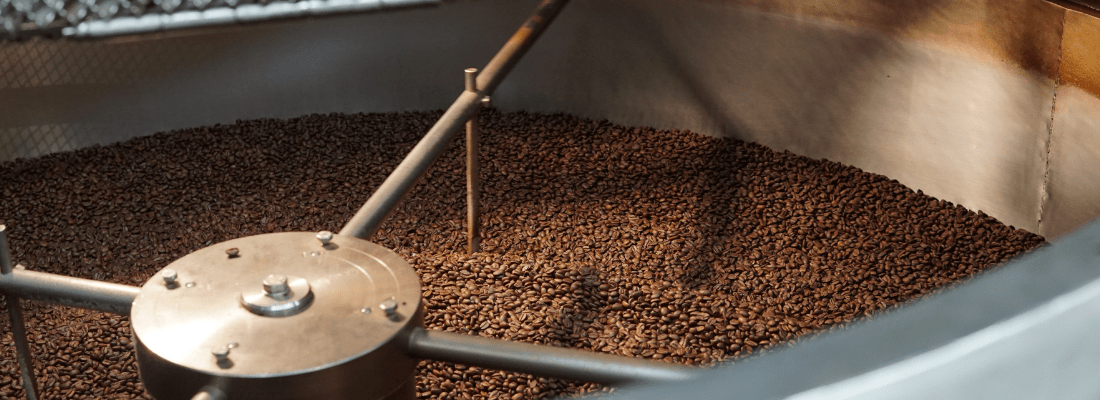Every step from planting to packaging explained
Coffee beans seem easy enough to produce. They are plucked from trees in a far-flung region of the world, sent to Merlo’s HQ for roasting and packaged up for sale instore or online.
But there’s a lot more to the process of producing coffee beans than you might think. And it doesn’t happen overnight, that’s for sure.
From the initial planting to the final delivery of roasted beans, this article will detail every step of how coffee beans are produced into the magical items of happiness that fill your cup every day.

Finding the right area to plant coffee seeds
Most of the world’s coffee is grown in an area called the ‘coffee belt’, which lies 23.5 degrees north and south of the equator.
Regions within the coffee belt are excellent for producing coffee because:
- The altitude of 900-1800m is ideal for growing.
- There is enough rainfall for the coffee plant to thrive.
- The stable temperature near the equator is necessary for optimal growth.
- Fertile soil is abundant.
These are the reasons why your next bag of coffee beans is more likely to have originated from Colombia, Costa Rica, or Ethiopia than it is from England or Iceland.

Planting and harvesting
Once the right area has been selected, the coffee seed is planted in a nursery, where it will stay until it reaches a suitable height to be planted in a coffee field.
It can take up to five years for these coffee plants to produce the coffee fruit, which is called the coffee cherry.
Once the coffee cherry is ripe it turns a glossy red colour, which means it’s time for the harvest to begin. Harvesting is generally done by hand, but machines can also be used.

Coffee production process
After harvesting, the coffee can be processed in a few different ways, including:
- The wet (or washed) process, where a pulping machine is used to remove the outer skin of the cherry, before soaking it in water to remove the pulp.
- The dry (or natural) process, where the whole coffee cherry is dried out before being hulled to remove the outer skin and inner parchment.
- The semi-washed process, which combines the first stage of the wet process - pulping to remove the outer skin - before the cherry is left to dry with the pulp still attached.
A hulling machine is then used to remove the final remaining parts of the cherry, leaving behind the green bean.
After this process is complete the beans are graded and sorted by size and colours. Beans with imperfections are removed to ensure only the best beans remain.

Exporting the beans
Once the green beans are ready, they are shipped in enormous hessian style bags from many different corners of the world to Merlo’s Headquarters in Brisbane.
In 2019-2020, an estimated 163.7 million 60-kilogram bags of coffee were produced for worldwide coffee consumption. Brazil is the world’s leading producer of coffee, accounting for over a third of the worldwide production figure.
Receiving the coffee
Once they arrive, green beans are stored at Merlo’s Bowen Hills and Eagle Farm warehouses where they are kept in cool, dry, and dark places. Green beans can stay fresh for up to 18 months, so they are only roasted when needed.

The bean roasting process
Merlo roasts over 20 tonnes of coffee a week at our Bowen Hills Torrefazione, and that amount will be increasing soon with the acquisition of a new state-of-the-art coffee processing plant for our Eagle Farm Headquarters.
There’s a lot involved in the roasting process, including how long the beans are roasted for which has a dramatic impact on their aromatics and flavours, and the cooling and destoning process. Learn more about the roasting process here.

Colour sorting
As an additional measure of quality control, all roasted coffee is then passed through an ASM colour sorting machine which ensures beans that are lighter or darker than the specified parameters are separated from the rest of the batch.
Read more about this fantastic machine here.
Grinding the coffee beans
The grind of your coffee beans is very important, especially if you don’t have a way to grind them yourself at home. At Merlo we offer a wide variety of grinds to suit your brewing device,
Whether you are purchasing online or instore, we can grind your coffee beans so they work perfectly with your chosen method of brewing.

Packaging it up
Whether it be whole beans or ground coffee, the final stage in getting coffee to you is packaging it up.
At Merlo we use specially designed bags and tins which are equipped with a one-way valve. This valve lets carbon dioxide out (which the beans naturally produce) while not allowing oxygen in. Oxygen and the oxidation process will alter your beans' unique balance of oils, which will then impact how quickly the beans go stale.

Instore or Online - coffee beans to you
You can find freshly roasted coffee beans at all Merlo-owned locations as well as on our Online Store.
Confused which beans to try? Give our sample pack a go!



